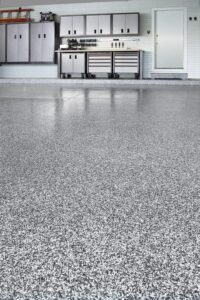Which Is Ideal for Residential Garages?

When deciding between garage epoxy flooring and rubber floors for your residential garage, you’ll need to weigh the pros and cons of each option carefully. Epoxy flooring offers exceptional durability and a seamless, stain-resistant surface, perfect for heavy vehicle use. On the other hand, rubber floors provide impact resistance and easy maintenance. The ideal choice for your garage ultimately depends on your priorities for longevity, maintenance, and appearance. So, which flooring option will best suit your needs and preferences? Keep reading to find out!
When considering garage flooring options, it is essential to understand the benefits and drawbacks of epoxy and rubber materials. Epoxy flooring offers a sleek and modern look to your garage, creating a space where you can feel proud to work on your projects. Its smooth surface makes cleaning a breeze, allowing you to maintain a tidy and organized workspace effortlessly. Additionally, epoxy flooring comes in a variety of colors and finishes, giving you the freedom to customize your garage to reflect your personality and style.
On the other hand, rubber flooring provides a softer and more cushioned surface, making it ideal for areas where you may be standing for extended periods. This can be particularly beneficial if you spend a lot of time working on your car or engaging in DIY projects. Rubber flooring also offers excellent insulation, helping to keep your garage warmer during the colder months.
Both epoxy and rubber flooring options have their unique advantages, so it’s essential to consider your specific needs and preferences when making a decision. Whether you prioritize a sleek appearance and easy maintenance with epoxy flooring or value comfort and insulation with rubber flooring, choosing the right garage flooring can enhance your overall garage experience and create a space where you feel like you truly belong.
For garage flooring that can withstand heavy use and resist wear over time, both epoxy and rubber options offer excellent durability. Epoxy flooring, known for its tough and resilient nature, provides a durable surface that can withstand the weight of vehicles, resist stains, and endure high traffic. Its seamless application creates a strong bond with the concrete beneath, enhancing its longevity and wear resistance. On the other hand, rubber flooring, made from tough and resilient materials, offers a cushioned surface that can withstand impacts, resist scratches, and provide insulation against cold temperatures. The elasticity of rubber allows it to bounce back from heavy loads and prevent permanent indentations, making it a long-lasting choice for garage floors.
Maintaining both epoxy and rubber garage flooring is straightforward and requires minimal effort to keep them looking their best. When it comes to ease of maintenance, both options have their advantages. Epoxy flooring, with its seamless surface, is resistant to stains and spills, making it easy to wipe clean with a mop or cloth. Its smooth surface also prevents dirt and debris from accumulating, simplifying the cleaning process. Additionally, epoxy flooring is resistant to chemicals and oils, ensuring that any accidental spills can be quickly and effortlessly cleaned up without causing damage.
To enhance the visual appeal of your garage, consider exploring the aesthetic options available for both epoxy and rubber flooring. When it comes to epoxy flooring, you have a wide range of colors and finishes to choose from. Whether you prefer a sleek, glossy look or a more subtle matte finish, epoxy can be customized to match your style and preferences. Imagine stepping into your garage and being greeted by a floor that not only complements the overall design of the space but also adds a touch of sophistication and charm. Epoxy floors can even mimic the appearance of materials like marble or granite, giving your garage a luxurious feel without the high cost.
On the other hand, rubber flooring offers its own set of aesthetic benefits. Available in various colors and patterns, rubber floors can add a playful or vibrant touch to your garage. Whether you want a solid color to create a modern look or a speckled design for a more dynamic feel, rubber flooring allows you to express your personality and create a space that feels uniquely yours. Additionally, rubber floors provide a soft and comfortable surface to walk on, making your time in the garage more enjoyable.
When installing garage flooring, you can expect a straightforward process that ensures durability and longevity for your chosen material. Whether you opt for epoxy or rubber floors, the installation process is designed to be user-friendly and efficient, giving you a reliable garage flooring solution.
For epoxy flooring, the installation typically involves preparing the concrete surface by cleaning and etching it to ensure proper adhesion. Next, a primer is applied to create a strong bond, followed by the epoxy coating, which is spread evenly across the floor. This is often accompanied by decorative elements like flakes or metallic pigments if desired. Lastly, a topcoat is applied to seal and protect the epoxy, providing a glossy and durable finish that can withstand heavy use.
On the other hand, rubber flooring installation involves interlocking tiles or rolling out rubber sheets, making it a simple and quick process. The tiles are laid down starting from one corner and interlocked to cover the entire floor area seamlessly. For rubber sheets, adhesive may be used to secure the material in place. Once installed, rubber floors offer cushioning and anti-fatigue properties, making them comfortable to stand and walk on for extended periods.
In conclusion, when deciding between garage epoxy flooring and rubber floors for your residential garage, it ultimately comes down to your personal preferences and specific needs. Epoxy flooring offers exceptional durability and resistance to wear, while rubber floors are known for their ease of maintenance and impact resistance. Consider your aesthetic preferences, maintenance ease, and durability requirements to choose the ideal option for your garage flooring.
